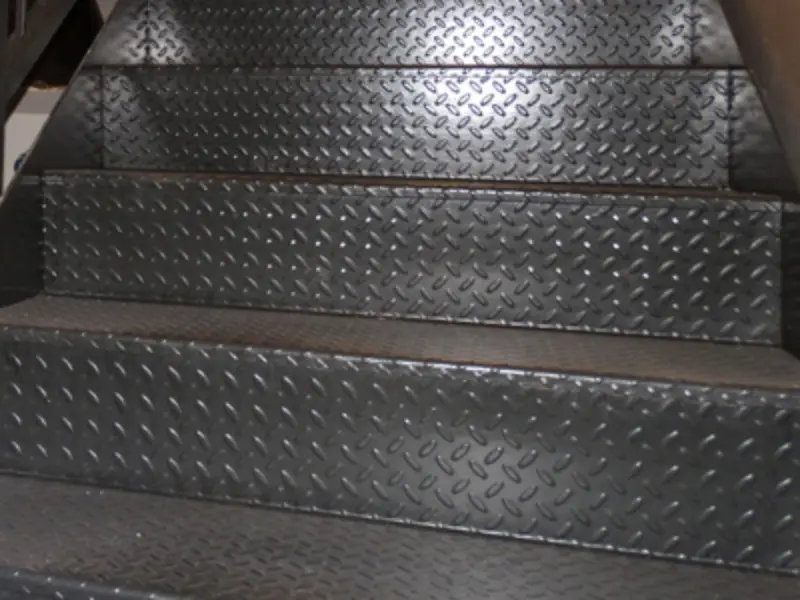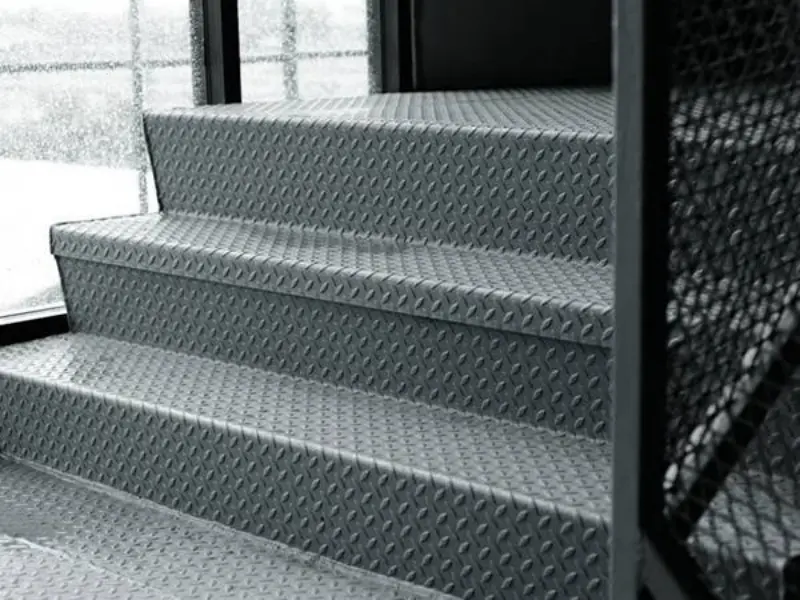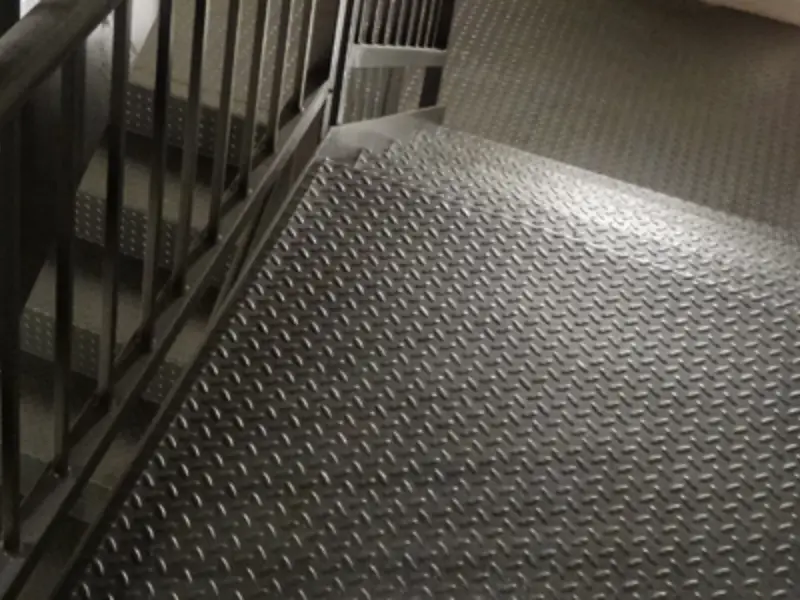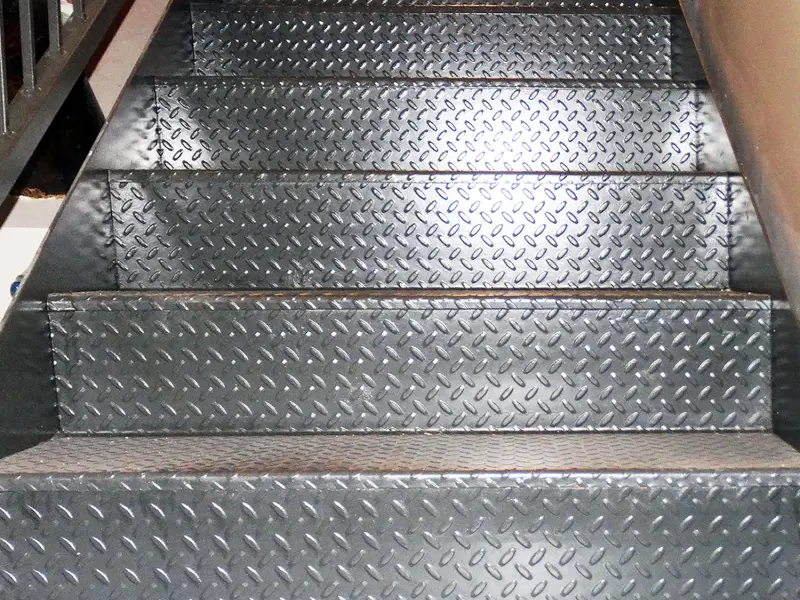Address
304 North Cardinal St.
Dorchester Center, MA 02124
Work Hours
Monday to Friday: 7AM - 7PM
Weekend: 10AM - 5PM
Address
304 North Cardinal St.
Dorchester Center, MA 02124
Work Hours
Monday to Friday: 7AM - 7PM
Weekend: 10AM - 5PM

Checkered plate stair treads provide an effective safety solution for various environments. Their slip-resistant properties, combined with durability and low maintenance, make them an excellent choice for industrial, commercial, and residential applications. When selecting treads, consider the specific environment, expected traffic, and maintenance requirements to choose the most suitable material and size.


Checkered plate stair treads are anti-slip metal steps made from patterned sheets, often used for industrial stairs, walkways, and safety platforms. The raised diamond or lentil patterns provide traction, preventing slips even in wet or oily environments.

These stair treads combine durability, strength, and safety — making them ideal for factories, construction sites, and commercial buildings.
| Item | Details |
|---|---|
| Material | Aluminum, Steel, Stainless Steel |
| Common Alloys | 3003, 5052, 6061 (Aluminum); Q235 (Steel) |
| Thickness | 2 mm – 8 mm |
| Tread Pattern | Diamond, Five-bar, Lentil, or Round Bead |
| Width | 600 mm – 1200 mm |
| Length | 800 mm – 3000 mm |
| Surface Finish | Mill finish, Polished, or Powder-coated |
| Edge Style | Serrated, Smooth, or with Nosing |
| Load Capacity | Up to 200 kg per step |

| Type | Description |
|---|---|
| Aluminum Checkered Plate Stair Tread | Lightweight, corrosion-resistant, ideal for outdoor and marine use. |
| Steel Checkered Plate Stair Tread | Strong and economical, suitable for heavy-duty applications. |
| Stainless Steel Checkered Plate Stair Tread | Rust-proof and aesthetic, commonly used in food plants or chemical industries. |
| Material Type | Thickness | Pattern | Best Applications |
|---|---|---|---|
| Aluminum | 1/8″ – 1/4″ | Diamond | Outdoor stairs, marine |
| Steel | 3/16″ – 1/2″ | Checkered | Industrial, heavy duty |
| Stainless Steel | 1/8″ – 3/8″ | Diamond | Food processing, chemical |
| Galvanized Steel | 3/16″ – 3/8″ | Raised pattern | General industrial |
| Pattern Type | Application | Feature |
|---|---|---|
| Diamond Pattern | Industrial stairs | High grip and strength |
| Five-bar Pattern | Public access stairs | Good anti-slip performance |
| Lentil Pattern | Machinery platforms | Smooth texture with traction |
| Round Bead Pattern | Commercial stairs | Aesthetic and anti-slip |
Checkered plate stair treads are widely used across industries and building types:
| Installation Type | Advantage |
|---|---|
| Bolted | Replaceable and secure |
| Welded | Strong and durable |
| Clipped | Fast and easy setup |
Checkered plate stair treads come in standard and custom sizes:
Standard Size Chart:
| Width | Length | Thickness | Weight Capacity |
|---|---|---|---|
| 8 inches | 36 inches | 1/4 inch | 300-400 lbs |
| 10 inches | 48 inches | 3/8 inch | 400-500 lbs |
| 12 inches | 60 inches | 1/2 inch | 500-600 lbs |
| Custom sizes | Available | Varies | As required |
Cleaning Schedule:
Maintenance Tips:
Compliance Table:
| Standard | Region | Requirements |
|---|---|---|
| OSHA | USA | Slip resistance, load capacity |
| ISO 14122 | International | Permanent access equipment |
| BS EN 13036-4 | Europe | Slip resistance measurement |
| AS 1657 | Australia | Fixed platforms and stairways |
Price Range Table:
| Material | Price per Tread | Lifespan | Maintenance Cost |
|---|---|---|---|
| Aluminum | $45-85 | 15-20 years | Low |
| Mild Steel | $35-65 | 10-15 years | Moderate |
| Stainless Steel | $75-120 | 20-25 years | Very Low |
| Galvanized Steel | $40-70 | 12-18 years | Low |
They provide a non-slip surface that enhances safety on stairs in high-traffic or slippery areas.
For general use, 3–5 mm aluminum and 4–6 mm steel plates are common choices.
Yes, especially aluminum or stainless steel treads due to their corrosion resistance.
Select five-bar or diamond for maximum grip, or lentil for smoother, easier cleaning surfaces.
| Feature | Details |
|---|---|
| Material Options | Aluminum, Steel, Stainless Steel |
| Pattern Choices | Diamond, Five-bar, Lentil |
| Thickness Range | 2–8 mm |
| Key Benefit | Anti-slip safety and strength |
| Main Applications | Industrial, Commercial, Marine |
| Installation Methods | Welded, Bolted, Clipped |
Checkered plate treads combine strength, safety, and design flexibility. Whether you’re building stairs for an industrial plant or a modern public facility, these anti-slip treads provide reliable performance and a clean, professional look.
Q: What material is best for outdoor checkered plate stair treads?
A: Aluminum is ideal for outdoor use due to its excellent corrosion resistance and durability.
Q: How do I clean checkered plate stair treads?
A: Use a stiff brush with mild detergent and water. Pressure washing works well for heavily soiled treads.
Q: Can checkered plate stair treads be customized?
A: Yes, manufacturers can custom-cut treads to specific sizes and patterns to meet project requirements.
Q: Are these treads suitable for food processing facilities?
A: Stainless steel checkered plate treads are perfect for food processing due to their corrosion resistance and easy cleaning.
Q: How do I prevent rust on steel checkered plate treads?
A: Choose galvanized steel or apply protective coatings regularly. Regular maintenance and immediate spill cleanup also help prevent rust.